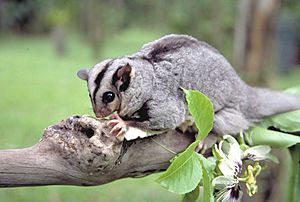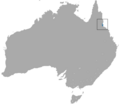Mahogany glider facts for kids
Quick facts for kids Mahogany glider |
|
|---|---|
 |
|
| Conservation status | |
| Scientific classification | |
| Genus: |
Petaurus
|
| Species: |
gracilis
|
 |
|
| Mahogany glider range | |
The mahogany glider (Petaurus gracilis) is a super cool gliding possum from Australia. It's an endangered animal, meaning there aren't many left in the wild. You can only find them in a small part of coastal Queensland, Australia.
Contents
What They Look Like
The mahogany glider is a night-time animal that lives in trees. It's a type of marsupial, which means the mothers carry their babies in a pouch, just like kangaroos!
This glider looks a lot like its relatives, the sugar glider, the squirrel glider, and the yellow-bellied glider. But the mahogany glider is bigger than all of them. It can be about 26.5 cm long, and its tail is even longer, around 34–40 cm! It weighs about 410 grams, which is like a can of soup.
The glider gets its name from its beautiful mahogany-brown belly. Its special gliding skin, called a patagium, is also this same rich colour. The tail is covered in short, soft hair and is black underneath.
Boys vs. Girls
Boy mahogany gliders are usually bigger than the girls. Even though they look similar in size, the girls are lighter.
- Girls are about 23 to 27 cm long and weigh between 310 to 454 grams.
- Boys are a bit longer, from 23 to 28 cm, and weigh more, between 345 and 500 grams.
- Even though girls are smaller, their tails are often a little longer in proportion to their bodies, measuring 35 to 41 cm, while boys' tails are 34 to 41 cm.
Where They Live
The mahogany glider lives in a very small area in North Queensland, Australia. You can find them between Ollera Creek (south of Ingham) and Tully.
Their home is mostly open forests. These forests have lots of different flowering plants that give the gliders food all year round.
Life Cycle and Reproduction
Mahogany gliders have a long breeding season. Babies can be born from April all the way to October. Usually, a mother will have one or two babies at a time, once a year. If a mother loses her first babies, she might have a second litter.
The young gliders drink their mother's milk until they are four to five months old. This is called being weaned. They become old enough to have their own babies when they are about one to one and a half years old. In the wild, they can live for about five or six years.
Adult gliders usually live in pairs and stay together. They share some of their dens (their homes in trees) with their young from the year before. They mark these dens to show other gliders that this is their territory.
What They Eat and Do
The mahogany glider has a varied diet! They eat:
- Sap and gum from eucalypt trees
- Sap and seeds from acacia trees
- Sap from grass trees
- Pollen and nectar from flowers
- Insects
- Mistletoe
- Honeydew (a sweet liquid made by some insects)
- Sticky stuff from wattle trees
- They also eat parts of at least twenty different types of trees and shrubs!
Since they are night-time animals, they are most active after the sun goes down. Adult gliders usually live together in pairs. A pair of gliders might use a large area of forest, about 23 hectares (that's like 23 football fields!). They travel quite far each night, often going about 1.5 km. They move around more during the wet season than in the dry season.
During the day, mahogany gliders sleep in dens high up in trees. They especially like poplar gum and forest red gum trees. Even though they live in pairs, they don't usually share the same den. Each glider might have three to nine different dens they use within their home range.
In January, gliders spend about 40% of their time outside their dens, traveling and finding food. By September, this increases to 77%. They are usually out for a continuous period of 8–10 hours during the night.
Mahogany gliders make deep, grunting sounds when they travel at night. If they are alarmed, they make a much louder, faster sound that some people say sounds like a lawnmower!
Who Eats Them?
Some animals that hunt mahogany gliders include:
- Scrub pythons (a type of snake)
- Owls
- Sometimes, feral cats (wild cats)
Protecting the Gliders
Mahogany gliders are considered a threatened species. This is mainly because they are losing their homes. Over 80% of their habitat has been cleared away to grow things like sugar cane, pine trees, and bananas, or to raise cattle.
Their existence was made even harder when Cyclone Yasi hit on February 3, 2011. This powerful cyclone caused a lot of damage to their region.
The mahogany glider was actually "lost" to science for over a hundred years! After it was first described in 1883, no one saw it again until it was rediscovered in 1989.
Good news! There are groups working to help these gliders.
- In 2000, the Queensland Parks and Wildlife Service started a special program to help the mahogany glider recover.
- The Wildlife Preservation Society of Queensland also has a program to protect gliders, including the mahogany glider.
- You can even see mahogany gliders in captivity at David Fleay Wildlife Park and Cairns Tropical Zoo. These zoos are part of breeding programs to help increase the number of gliders.
Images for kids




